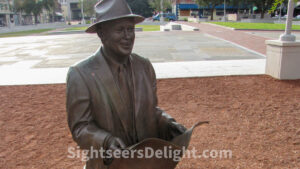Savannah honors hometown legend Johnny Mercer, one of America’s greatest songwriters, with a life-size bronze unveiled on Nov. 18, 2009, the centennial of his birth. Mercer penned more than 1,500 songs across a five-decade career; “Moon River,” the theme from “Breakfast at Tiffany’s,” is his best-known classic and one of four Academy Award winners. The statue captures Mercer’s approachable charm, wearing a hat and an overcoat, a newspaper in hand, and his trademark gap-toothed grin. Set in Ellis Square, steps from City Market, it’s an easy photo stop and a fitting tribute to the Savannah native whose lyrics often echoed his love for Georgia. A restored version of the statue returned to Ellis Square in 2023.
31401
John Robert Godley was an Anglo-Irish statesman and bureaucrat. Godley is considered the founder of Canterbury, New Zealand, although he lived there for only two years. A bronze statue bearing his likeness was erected in Cathedral Square by the people of Christchurch in 1867. Artist Thomas Woolner designed the statue, which fell off its pedestal during a February 2011 earthquake.
The John Wesley Monument, erected in 1969 by the John Wesley Monument Committee, honors the founder of Methodism, who served as an Anglican clergyman in colonial Georgia from 1736 to 1738. Set in the center of Reynolds Square, on the site where Wesley’s Savannah home is believed to have stood, the statue depicts him preaching outdoors, reflecting his practice of ministering in the open air, including to Native Americans, which challenged the church convention of the day. During his Savannah tenure, Wesley established what is widely regarded as America’s first Sunday school, foreshadowing Methodism’s focus on teaching and small-group faith. The bronze monument by sculptor Marshall Daugherty is located near Bay Street and City Market.
31401
The Key West Veterans Memorial Garden is located in Bayview Park and commemorates those who served and sacrificed for the country. The garden, located in Bayview Park, opened in 2015. It includes placks with information about wars involving American soldiers. The garden also includes the Civil War Forgotten Soldier Memorial, unveiled in 2016 and honoring the more than 120 black soldiers from Key West who served the Union during the conflict.
33040
Located in central London between The Mall and Carlton Gardens, the King George VI and Queen Elizabeth Memorial is a tribute to King George VI and his spouse, Queen Elizabeth. The memorial was completed in 2009 and features a Grade II listed statue of George VI created by William McMillan and unveiled by his daughter Queen Elizabeth II in 1955. The updated memorial includes a statue of the Queen Mother by Philip Jackson, a relief sculpture by Paul Day and an architectural setting by Donald Buttress and Donald Insall. Queen Elizabeth II unveiled the updated memorial in 2009.
The Korean War Veterans Memorial honors those who fought in one of the nation’s forgotten wars and one that has ramifications still felt today. The memorial features statues of 19 soldiers representing a patrol squad. The 19 soldiers reflect in a granite wall, giving the illusion of 38 soldiers, representing the 38th parallel that divides North and South Korea. The Korean War Veterans Memorial was dedicated in 1995 on the 42nd anniversary of the deal ending the war.
20024
Leatherlips is one of Ohio’s great historic legends. He was executed in on June 1, 1810, though the precise location is open to some debate. To honor the great Wyandot Native American Chief, the Dublin, Ohio, community in 1990 unveiled a 12-foot high sculpture of Leatherlips’ head. Designed by Boston artist Ralph Helmick and located in Scioto Park, the portrait was made using stacked native limestone. The top is open with stacked stones extending back along its sides, making for a popular picture stop.
43065
In April 2007, a statue was unveiled in downtown Clarksville, Tennessee, honoring Lenora “Nora” Witzel, who has been described as a pioneer and a rebel. Witzel (1875-1968) photographed Clarksville’s architecture and people for nearly three decades. She worked out of her photography studio at the ML Clothing Store on Franklin Street and is considered a pioneer of early 20th century small-town photography. Andrea Lugar of Lugar Art and Bronze Foundry in Arlington, Texas, created the life-sized bronze cast of Witzel and her dog Nettie.









